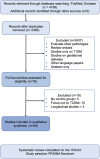A systematic review on gut microbiota in type 2 diabetes mellitus
- PMID: 39897957
- PMCID: PMC11782031
- DOI: 10.3389/fendo.2024.1486793
A systematic review on gut microbiota in type 2 diabetes mellitus
Abstract
Aims/hypothesis: The gut microbiota play crucial roles in the digestion and degradation of nutrients, synthesis of biological agents, development of the immune system, and maintenance of gastrointestinal integrity. Gut dysbiosis is thought to be associated with type 2 diabetes mellitus (T2DM), one of the world's fastest growing diseases. The aim of this systematic review is to identify differences in the composition and diversity of the gut microbiota in individuals with T2DM.
Methods: A systematic search was conducted to identify studies reporting on the difference in gut microbiota composition between individuals with T2DM and healthy controls. Relevant studies were evaluated, and their characteristics and results were extracted using a standardized data extraction form. The studies were assessed for risk of bias and their findings were reported narratively.
Results: 58 observational studies published between 2010 and 2024 were included. Beta diversity was commonly reported to be different between individuals with T2DM and healthy individuals. Genera Lactobacillus, Escherichia-Shigella, Enterococcus, Subdoligranulum and Fusobacteria were found to be positively associated; while Akkermansia, Bifidobacterium, Bacteroides, Roseburia, Faecalibacteirum and Prevotella were found to be negatively associated with T2DM.
Conclusions: This systematic review demonstrates a strong association between T2DM and gut dysbiosis, as evidenced by differential microbial abundances and altered diversity indices. Among these taxa, Escherichia-Shigella is consistently associated with T2DM, whereas Faecalibacterium prausnitzii appears to offer a protective effect against T2DM. However, the heterogeneity and observational nature of these studies preclude the establishment of causative relationships. Future research should incorporate age, diet and medication-matched controls, and include functional analysis of these gut microbes.
Systematic review registration: https://www.crd.york.ac.uk/prospero/, identifier CRD42023459937.
Keywords: diabetes; diabetes mellitus; gut dysbiosis; gut microbiota; systematic review.
Copyright © 2025 Chong, Lin, Chong, Jensen and Lau.
Conflict of interest statement
The authors declare that the research was conducted in the absence of any commercial or financial relationships that could be construed as a potential conflict of interest.
Figures





References
-
- Mayenaaz Sidhu DVDP. The gut microbiome. Aust J For Gen Practitioners. (2017) 46:206–11. - PubMed
Publication types
MeSH terms
LinkOut - more resources
Full Text Sources

